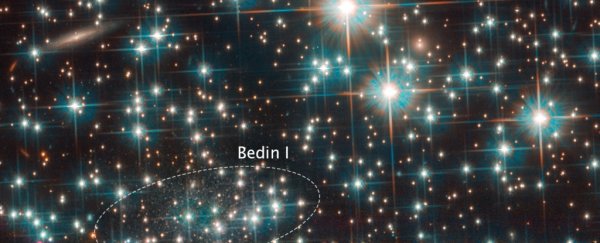Humanity is getting pretty good at looking deep into space. We've peered back over 13 billion light-years. We've seen - actually seen - two neutron stars colliding. We're homing in on fast radio bursts, and we're about to see, for the first time, the event horizon of a black hole. But there are still some surprises out there, even in our own corner of the Universe.
While taking observations of a nearby globular cluster, the Hubble Space Telescope accidentally caught a previously unseen galactic photobomber in the distance. The newly discovered galaxy has been named Bedin I - and it's nearly as old as the Universe.
The mission was to look for the faintest stars in NGC 6752, a globular cluster 13,000 light-years away within the Milky Way's halo, where a bunch of globular clusters just hang out.
But in the distance - around 30 million light-years away, roughly 2,300 times more distant than the star they were aiming at - Bedin I was lurking. (The Local Group is about 10 million light-years across; if you think of it like a block, 30 million is like being in the same cosmic town.)
"We report the discovery of Bedin I, a dwarf spheroidal galaxy too faint and too close to the core of NGC 6752 for detection in earlier surveys," the researchers wrote in their letter describing the find.
"We have discovered this object serendipitously with extraordinarily deep Hubble Space Telescope images obtained for the purpose of investigating the white dwarf cooling sequence of the globular cluster NGC 6752."
Bedin I is tiny, and isolated, and ancient. It's just 3,000 light-years across, compared to the Milky Way's estimated 100,000 light-years, and it's roughly 1,000 times fainter. It's been classified as a dwarf spheroidal galaxy.
Usually, dwarf spheroidal galaxies are companions to larger galaxies or systems, but not Bedin I. It is 2 million light-years from the closest galaxy that could be considered a host, spiral galaxy NGC 6744.
Based on the light it emits, the team was able to determine that the galaxy is very low in metals. Since heavier elements, such as metals, were created in stars and only propagated throughout the Universe after those stars died, this indicates that Bedin I has a very old population of stars.
The team estimated that the galaxy is around 13 billion years old - add just 0.8 billion years, and it would be as old as the Universe itself. The low metal content implies that Bedin I came into being in a burst, and hasn't had any new star formation since.
This means it's a sort of cosmic 'living fossil' or time capsule, preserving the conditions of the early Universe.
Given that Bedin I is so far away, and so faint, and obscured by closer stars, it's amazing that it was discovered at all - and by the Hubble Space Telescope, which has been in operation for nearly 30 years now. We hope it keeps going for many more.
The team's paper has been published in the Monthly Notices of the Royal Astronomical Society: Letters.
